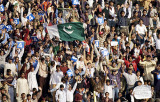
|

Lahore's fans may have to deal with fog, fading light and bitter chill before they see the conclusion of the first Test
© Getty Images
|
|
As the fulcrum of Pakistan's first conventional home season - hosting two series of three Tests - since 1998-99 approaches, an infrequent theme lingers through it - the weather. Arguably, England were the biggest losers in the preceding series but with nearly 90 overs lost, mostly in Faisalabad and Lahore due to poor light, time ran them a close second. Nine days running, from the beginning of Faisalabad to the end in Lahore, play ended early, in smoggy, foggy haze and fading light, and each time so soon after tea that the final session became near-redundant. Such was the concern that the PCB publicly floated the idea of a six-day Test during certain periods of the season in Pakistan. Although yet to be discussed officially the ICC agreed that the proposal merits serious consideration. It looks likely, with India's visit and an abnormal winter, to linger a little longer.
Fittingly, the last time the climate really became a sub-plot was in that 1998-99 season. Australia had come and gone and Zimbabwe arrived to take advantage of an unraveling Pakistan in late November. They pulled off an upset in Peshawar but would have been thankful for conditions thereafter that saw the last Test at Faisalabad abandoned due to fog without a ball being bowled and the second at Lahore where over 200 overs were lost for similar reason.
History doesn't grant it isolation. When India toured in 1982-83, two late January days were lost in the fifth Test at Lahore due to thunderstorms. Pakistan hadn't played a Test in exactly a year when Sri Lanka visited in December 1991; by the time the series ended in early January, despite having won it, they might as well not have bothered. The first Test in Sialkot, pestered by bad light ended nearly 50 overs and a probable Pakistan victory short. Still at least it wasn't Gujranwala, the scene for the second Test; 40 miles north of Lahore, persistent drizzle and fog allowed 36 overs on the first day and none after. In December 1993, when Zimbabwe became the first tourists in two years, December's fading light again spoiled two days in the last Test at Lahore.
It is a casual recourse to history but already from it, two commonalities can be extracted and are particularly pertinent to the scheduling of this India series. The first is the time of year; mid-December to early February are by the consent of most meteorologists, a problematic period for cricket in parts of Pakistan. Fog becomes a Lahori curse from five in the morning till approximately 11am when it is often heavy, and although it lifts, it is only to descend again with renewed vigour in late afternoon and early evenings. Precluded of early starts and extended finishes, play thus stands a good chance of curtailment.

|

The Indians have already donned extra layers during their chilly warm-up match against Pakistan A
© Getty Images
|
|
This winter has been particularly severe, despite some Met department officials' bewildering claims that it isn't abnormal. Northern areas have been particularly badly hit; even Karachi in the south has seen record low temperatures (as low as five degrees) and parts of Punjab, including Lahore, have seen the mercury drop below zero for the first time since 1967. Although, clear skies and sunshine have come recently, more fog - and rain - is not being ruled out this month.
Yet Pakistan has always had a broad international season; the only months that haven't seen an international fixture are June and July. Bangladesh once came in August, New Zealand, albeit with extenuating circumstances, in May. October to April, says the PCB, is the official season but in the 80s, despite Imran Khan's long-standing assertion that it was too hot to play, Australia toured whenever September did (Imran famously skipped the series in 1988 for the same reasons). Agha Zahid, the PCB's chief curator says the ideal times for play are from October to mid-December and then February till April. With two Tests scheduled to finish before January does, the hastiness with which this series has been accommodated may yet tell against it.
The other commonality of course is the region. Every aforementioned incident has occurred in Punjab, the province most vulnerable to weather extremes and where India play their first two Tests; outside it matches fall prey to riots, poor pitches, facilities but rarely nature. Forget time lost for as Zahid asserts, pitches also suffer. "Preparing good pitches requires stable weather. The excessive cold puts much moisture in pitches and pitches need to be baked. Without sustained sunshine it isn't easy but in other parts of the country, with drier and warmer conditions it's not a problem."
And yet, in recent years, matches outside Punjab have been rare. Political circumstances haven't helped, although even then, in the cases of Peshawar and Karachi, the PCB's will has been frail. Neither though has an inability - or unwillingness - to develop and promote grounds around the country. The Niaz Stadium in Hyderabad exemplifies this: once an international venue, it has festered to such an extent that last month, shamefully, it was used as a marriage venue by local politicians.
Inshallah, say weathermen and Zahid, conditions will not affect play through time lost or poorly-prepared pitches during this series. Maybe too the PCB can help, by proactively organizing a split home calendar, leaving out December and January, and looking beyond one region for venues. You might not then need a six-day Test.



